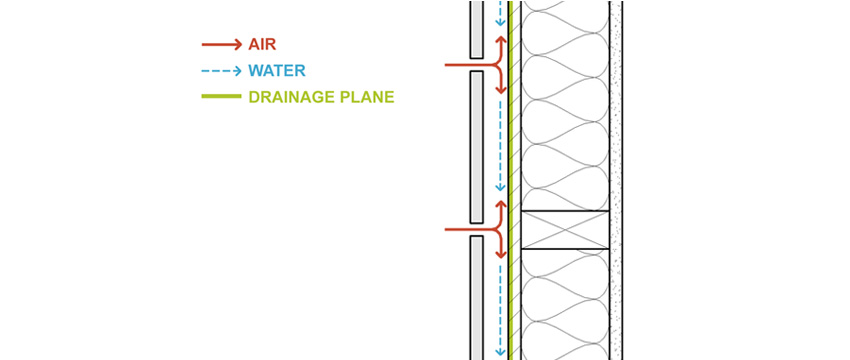Who’s the Culprit in WRB-AB Leakage?
Drying Capability
Selecting an effective WRB and AB and making them truly continuous means that bulk water and unwanted air infiltration is kept out of the wall assembly from the exterior side of the wall. However, there is a legitimate concern about moisture in the form of liquid and/or water vapor penetrating through openings in the interior drywall and/or vapor retarder and ending up in the insulated cavity of the wall assembly. If that vapor is then trapped because of the presence of a vapor barrier and not allowed to diffuse or escape from the cavity, it can cause mold to grow or moisture damage to the wall and surrounding construction. The best solution is to use a WRB and an AB that can restrict bulk water and air but still be permeable enough to allow vapor to diffuse out over time, thus creating a full drying capability for the wall. This aspect of an exterior wall assembly is commonly reinforced by building scientists as a safeguard against degradation of the wall. There are a variety of products that provides this balance of WRB-AB protection and permeability to allow for cavity drying when needed, with integrated sheathing being one common example of such a product.

The ability of an exterior wall to drain away moisture and allow drying is critical to the success of its long-term durability and performance.
Regardless of which choice is selected for AB and WRBs, some form of cladding is typically installed over it to create the exposed, visible, exterior wall surface. Such cladding could be masonry, metal, wood, fiber cement, or some other material, any or all of which could be used on a single building. Each of them will have their own performance and design characteristics, and their manufacturers will have their own recommended or preferred method of installing them. In virtually all cases though, good building science indicates that the key to a successful wall assembly is to provide for a gap or space between the selected cladding and the WRB-AB. This gap allows for any bulk water that does enter behind the cladding, or any condensation from moisture that occurs, to drain down the face of the WRB and exit the assembly safely through flashing, weep holes, etc. This makes the wall “drainable” but also helps directly with the drying capability of the wall since the gap and related drainage outlets will allow moisture in the wall assembly to escape harmlessly.
Construction Technique
Understanding the principles discussed so far is important, but often the biggest issue in achieving them is to understand the capabilities and limitations of a specific construction technique. For example, providing a gap and drainage space has been very commonly and appropriately used in masonry construction to retain the integrity of the total wall assembly. This approach recognizes that some masonry may be porous and allow for bulk water to enter behind the masonry cladding, or rainwater may enter somewhere else (such as near an opening) and get trapped between the masonry and the sheathing. Hence, common flashing techniques and weep holes or similar means are employed to collect and drain away the water.
For cladding types other than masonry, such as panels made of metal, composite, wood, or other materials, the cladding may be supported and held away from the sheathing with some type of support or spacer system. Commonly, metal girts or spacers are used that can be installed in various ways and with different components or coordinated systems. Horizontal metal Z-girts are one common type of this construction technique to create the gap and keep everything else in place. The horizontal girts are secured to the framing members and, in turn, provide continuous support of the cladding secured directly to the girts. The Z shape provides a space for rigid insulation to be installed in the depth of the girts and supported in place. Note that these Z-girts are often installed either horizontally or vertically and the horizontal installation may interfere with drainage capabilities across the sheathing surface. In those cases, if not properly detailed and accounted for, the top face of the girts could collect water.
Spaced clips are an alternative approach to using Z-girts. These individual clips are fastened through the sheathing into the framing in order to be securely held in place. The clips then provide spot support for cladding instead of the continuous support provided by girts. Similar to girts, the depth of the clips can be sized to provide the appropriate thickness of rigid insulation to be installed between the cladding and the sheathing. Unlike horizontal girts, the clips maintain space between them to allow for the free drainage of water down the sheathing/WRB surface.
Cladding Impact on WRB-AB
A key component of any of these construction techniques discussed is the use of fasteners, such as screws or bolts, to secure cladding directly to the exterior sheathing or secure girts, spacers, and insulation that support the cladding. In so doing, these fasteners must also penetrate through the WRB-AB that was so carefully prepared to be continuous. In so doing, they breach the WRB-AB and can cause leakage unless they are properly addressed. Hence, the various means of providing cladding attachment will have a direct impact on the integrity and continuity of the WRB-AB on the exterior sheathing.
All of these different principles and techniques that we have touched on so far lead us to the question of exactly how much the attachment of cladding impacts the continuity or creation of leaks in WRBs and ABs. Some would hypothesize it is a big impact, some might declare that the impact is minor, and others might say that “it depends” due to the variables and choices described. In order to fully determine who the real “culprit” is in WRB-AB leakage, we need to ask some fundamental questions:
- How significant are the fasteners when they penetrate?
- How significant are the cladding attachment systems and their orientation (vertical or horizontal)?
- Does the type of WRB-AB used in a wall assembly make a significant difference on performance?
- What building conditions and climate traits come into play?
In order to answer the questions properly, the best way to proceed is with demonstration testing of different wall conditions subjected to different air and water conditions, all in a testing laboratory.
The Test
In response to all of the foregoing, we now turn our attention to some actual demonstration testing that was undertaken specifically to address the questions we have raised. In order to understand the parameters of this work, we focus first on describing the basic physical setup of the testing and then look at the specific test methods used.

Independent testing by RDH Building Science in Waterloo, Ontario, is the basis for the test and results discussion in this course.









